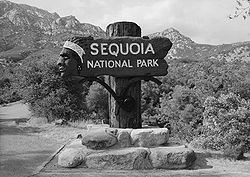NRHP Reference # 78000367 Year built 1935 Nearest city Three Rivers | Area 404.7 m² Added to NRHP 27 April 1978 | |
 | ||
Similar Crystal Cave, Giant Forest, Giant Forest Museum, Moro Rock, Tharp's Log | ||
The Ash Mountain Entrance Sign at Sequoia National Park was constructed in 1935 by Civilian Conservation Corps craftsmen. Featuring a carved Native American face, the sign was made from blocks of sequoia wood and fastened with wrought iron brackets.
The design was first proposed by National Park Service architect Merel S. Sager in 1931, who designed a small log sign for the Ash Mountain entrance. In 1935 resident park landscape architect Harold G. Fowler created a much larger design. He recruited CCC worker George W. Munro, who had displayed a talent for woodworking, and they selected a piece of fallen sequoia wood from the Giant Forest. Fowler sketched the profile in blue chalk on the wood using an Indian Head nickel as a guide. Munro carved the wood over a several-month period and the sign was assembled and erected over the winter of 1935-36. It was moved in 1964 to make room for a new park entrance station.
The sign is supported by a four-foot-diameter sequoia log rising from a two-tiered masonry platform. The sign panel is ten feet wide by four feet high and one foot thick, carved into a profile reputed to signify Sequoyah, whose Cherokee tribe never inhabited California. The sign was originally unpainted, but assumed its present appearance in the 1950s. As originally built, a matching log pylon stood on the opposite side of the road. The pylon was removed when the sign was relocated.
